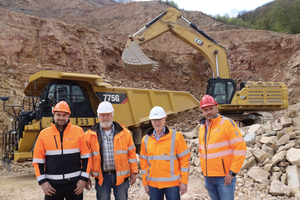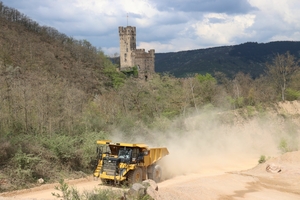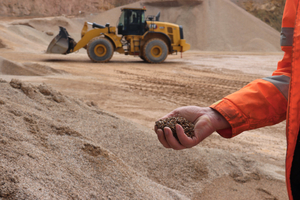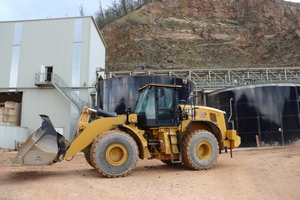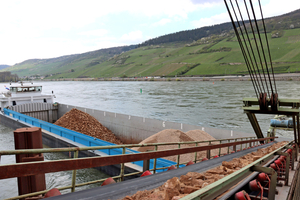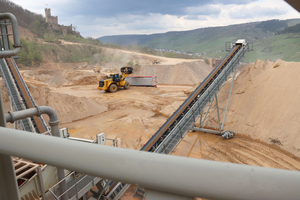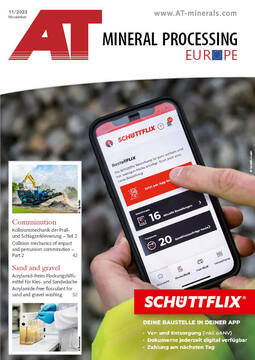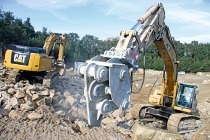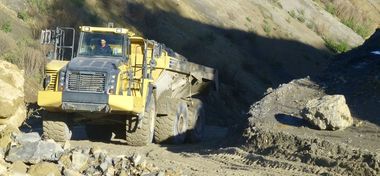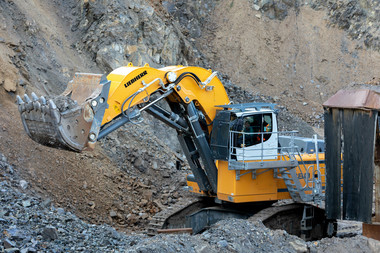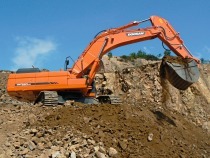Economical construction machinery technology from Cat for challenging mining conditions
If you enter this street name under the postcode 55413 into your sat nav, you will land above the Rhine and then look down on Germany’s longest river, surrounded by vineyards and medieval castles. Between Mainz and Koblenz in Trechtingshausen in the world and natural heritage “Middle Rhine Valley” sits the Hartsteinwerke Sooneck GmbH, which has belonged to the Dutch group of companies de Beijer Groep BV from Dodewaard since 1963 and is celebrating its 60th anniversary this year. The quarry, which is located in a tectonically highly stressed part of the Rhenish Slate Mountains, has been known since 1650.
Various loading points are spread across the partly highly fissured deposit: sometimes it is a Cat 374 crawler excavator that feeds Cat dump trucks such as a new 775G to transport the quartzite, which has been loosened by blasting or cracking, to the crusher for further processing. They represent a new generation of construction machinery that makes quarrying economical but also sustainable. Sometimes they are Cat wheel loaders, such as two 972 XE in back loading, or a new 982 loading a Skw for ship loading. There are other Skw of the 775 model in circulation, an additional 775G, twice a representative of the E series and one belongs to the F series. Their front and rear axles are particularly stressed when the rigid-frame dump trucks travel downhill on driveways fully loaded. “Dump trucks have to cope with an average gradient of 16 % at the site. This puts quite a strain on the brakes and tyres. But the fuel consumption is all the more astonishing. The dump trucks drive uphill empty, fully loaded they reach 110 tonnes. The weight pushes the Skw downwards, so we use much less fuel when driving downhill,” explains Udo Wirth, the former operations manager who advises the hard stone works. The latter is currently following developments with regard to electric mobility. “For us, electric trucks that recuperate and thus recover energy when driving downhill would be an interesting option to reduce emissions,” says Han de Beijer, managing director of the group of companies.
In order to make the mining process efficient, the technology is permanently in the focus of Stephan Abraham, Operations Manager, and Michael Gard, Technical Manager. With foresight, tyres of the Skw with appropriate radial depth and with 150-% tread depth are used, which have a zigzag centre groove with countersunk rib to ensure high traction. Going downhill with a full load is also detrimental to the brakes as well as the driveline. When driving downhill, the oil-cooled retarder helps to prevent the brakes from overheating, but the high weight of this operation over the years stresses the components.
Six different types of hydraulic construction stone are produced, which are used on inland waterways in Germany and the Netherlands, as well as on offshore construction sites on the North Sea coast, as well as mixtures for road construction and washed chippings and sands for concrete and civil engineering. “Currently, we have to produce a particularly demanding grading curve with the Cat 982, which is being installed in Rotterdam as the substructure of tank farms. With the wheel loader in back loading, the integrated scale supports us to mix 5 different grain sizes with the right dose. Our strengths are mixes where every tonnage counts. We have good sales staff who advise customers accordingly and we find them the right product for the application,” says Udo Wirth. Samples are tested in the company’s own laboratory and criteria such as the necessary raw density for the customer mixtures are determined in order to meet the high quality requirements. For each product, an indicator is created per tonne of material to record its CO2 impact, which occurs during production up to delivery.
A special feature at the site is the wet processing, which exists alongside the dry processing in order to utilise the raw material at the site as completely as possible and to conserve primary raw materials in the sense of sustainability. Coarse and fine aggregates up to 0/1 mm are screened out wet, the clay and silt fractions smaller than 63 µm are separated from the process water in a complex process and dewatered by means of a chamber filter press to form a compact “filter cake”. This is in turn stockpiled with the aid of a Cat 330FLN crawler excavator. The “filter cake” is marketed as Rheinstein clay. Due to its high quality, it is in demand for roofing and masonry tiles, façade and paving clinkers or for sealing landfills and dykes. “There are more and more enquiries from the region,” Han de Beijer is pleased to say.
The extraction site benefits directly from its geographical location on the water - its own ship loading point and inland waterway vessels help to bring the extracted building materials to the customers by truck over long distances via the waterway up and down the Rhine, also to neighbouring countries, without intermediate transports. However, the water level of the Rhine restricted the transports last year. “The permanently low water level of the Rhine due to the long dry periods of the last few years and the increasing loss of the glacier water inflow from the Alps have meant that we have increasingly served our customers by road. The major customer at present is dyke construction, but we are also experiencing high demand in other areas. In particular, we continue to supply large construction sites, which take 3000 to 5000 t from us every week, by ship,” says Han de Beijer.
Looking for new sales channels and constantly putting production to the test is one of the core tasks of the group of companies in order to become more economical and sustainable. This led, for example, to the company changing the excavation method from high to backhoe excavators. In the meantime, a Cat 374 crawler excavator has been installed for the second time. For the quarry, this means a higher production output compared to the previous model. The new excavator can load a dump truck in the quarry up to ten times per hour if necessary. A so-called heavy-duty mode ensures high system pressure so that heavy loads can be picked up effortlessly. The 10 % higher slewing torque ensures faster cycle times. Three performance levels allow the machine to be adapted to different tasks: Power for maximum, Smart for balanced and Eco for particularly energy-efficient operation.
Excavator operators working in the quarry benefit from a modern cab with automatic climate control, modern viscous overlays to reduce cab vibration and conveniently located controls. Compared to previous generations, the new Cat 374 offers a stronger design. This is achieved through the reinforced design of the booms, booms and upper and lower frames for tough, heavy-duty applications such as those common in a quarry.
Nevertheless, the machine operators must always be made aware of regular machine maintenance and the importance of daily machine checks. Therefore, there are driver training courses conducted by Zeppelin. “Our quarrying is very demanding not only because of the twelve levels. Quartzite is very abrasive and that affects wear, which we always keep an eye on,” says Han de Beijer. That is why appropriate precautions have also been taken with the new wheel loader technology in the form of the Cat 982 as well as the two Cat 972MXE and the underscrew blades on their buckets have been reinforced accordingly.
But it does not always have to be new machines that are used. So the company weighs up which technology best suits the requirements and is specifically advised here by Area Sales Manager David Decker from Zeppelin’s Frankenthal branch. This led to the decision to use young used machines such as the Cat 330FLN crawler excavator or to make use of the Cat Certified Rebuild programme. For the third time, two Cat Skw type 775E and one type 775F were made fit again for another machine life by the Zeppelin branch in Frankenthal. “This has given us machines that are almost as good as new, with which we can also work with low fuel consumption,” says Han de Beijer. The three rebuild trucks are in turn supported by two new Cat 775G, which feature efficient operation through adjustable fuel-saving modes. The Cat C27 diesel engine used in the new G-Series dump truck offers high torque for demanding work applications, allowing it to better handle inclines. So that it can then deliver its required power “in paradise” down to sole twelve.

